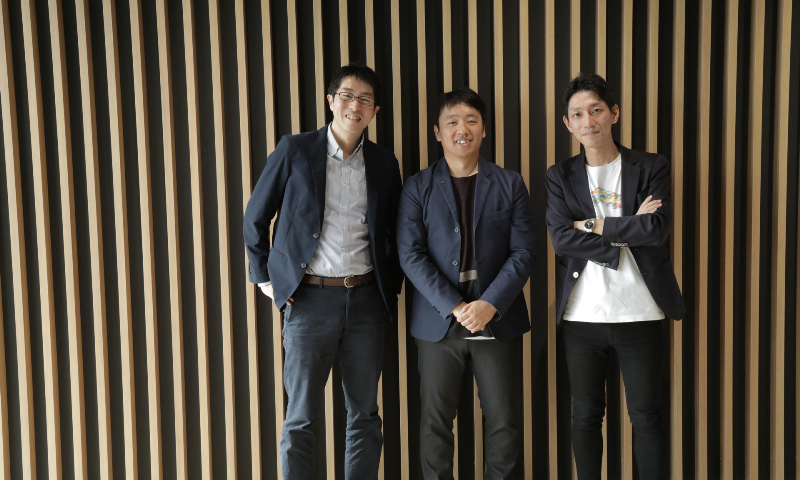
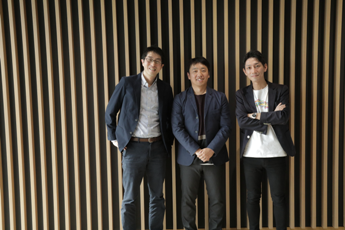
Left: Noriaki Imaoka (Staff Engineer, Robotics Promotion Office, Manufacturing Innovation Division, Panasonic Corporation)
Middle: Hiroyuki Uematsu (Staff Engineer, Robotics Promotion Office, Manufacturing Innovation Division, Panasonic Corporation)
Right: Kazumichi Shirai (Mananger, System Development Department, WHILL, Inc.)
*Filming date: November 20, 2018
A cross talk was held with three robotics engineers: Kazumichi Shirai, mananger of the System Development Department of WHILL, Inc., which has the mission of “Making movement fun and smart for everyone” and Hiroyuki Uematsu and Noriaki Imaoka, both chief engineers in the Robotics Promotion Office of the Manufacturing Innovation Division of Panasonic Corporation. We asked them about the strengths of co-creation, the significance of robot development, and the positioning of Robotics HUB.
There are strengths in co-creation.
Q: What led your two companies to co-creating?
Shirai: We first were working with Panasonic on a project related to the Paralympics and during that time there was some discussion that we and Panasonic should collaborate on a more company-wide basis. It was at this time that some people working on HOSPI (autonomous mobile robot) wanted to use the technology of WHILL and HOSPI to create new personal mobility with autonomous driving, which I think was the beginning of this project.
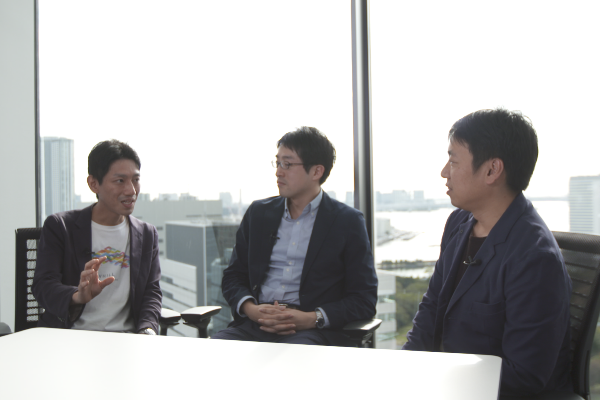
Uematsu: WHILL, Inc. had created a wheelchair with a very characteristics design and I felt that if we combined it with innovation and automation technology that it would be futuristic and have lots of potential.
Imaoka: Looking at it from the perspective of supporting mobility, when I thought that rather than thinking only about people with walking disabilities and thus focusing only on electric wheelchair automation, we could expand our vision to provide services to healthy people as well but then tended to look at it from a negative perspective, WHILL, Inc. used their design to show a positive perspective, which I thought matched well with Panasonic’s philosophy.
Shirai: The mission of our company is “Making movement fun and smart for everyone,” so we want to create a world where everyone can use the new vehicle called personal mobility. I think it is very significant that Panasonic understands this and we can work together with them.
Q: What are the merits to both parties of collaboration?
Uematsu: What I think is the most fun is when we think about how we can utilize the strengths of WHILL, Inc. and then feel that we have something that will be the best product. WHILL, Inc. moves at a speed that we can’t, so this is stimulating for us in the sense that we have to keep up with them.
Imaoka: We are being very careful when adding our part that we do not harm WHILL’s design. When we look at the details, we see how well they have thought it through and their desire for a variety of people to be able to use it. For example, we are working together with them on the control portion, and it is informative for us to see the approach they take to control so that it will move properly, such as not accelerating rapidly.
Shirai: They are looking very closely at the details. That is a very good thing for us. One of the merits of working together with Panasonic is learning from their approach to safety. Further improving safety is something I have come to realize as an engineer. We try to respond to their requests as quickly as possible. A sense of speed is very important in our company. Even though Panasonic makes some requests that are so detailed as to be amusing (laughing). All the communication is carefully done and I feel that our face-to-face meetings are very important. At the beginning in particular I think we were able to mutually move forward on the project without discrepancies by reviewing the software contents together.
Imaoka: When we had an issue, we took the items to WHILL and had them look at it with us. They always had everything ready immediately, which was a real help.
Shirai: We make things, so there are somethings you just can’t know without actually seeing them. Getting immediate feedback was also one of the reasons we could proceed smoothly.
Q: What is required to improve the results of co-creation?
Uematsu: From a frontlines perspective, Panasonic is strong in product development being able to utilize the culture, history, and heritage it has accumulated to date. When collaborating, it is important to align with the other company’s culture. While this might be possible on the frontline level, it think it is more difficult to do it on the company level.
Shirai: I think it is a leader’s perspective.
Imaoka: Currently, almost all of our questions are going to Mr. Shirai. That is fine as a contact, but his specialty is control, so sometimes I wonder if it’s good to be asking him about mechanisms. I think communication might go smoother if the respective people in charge talked directly with each other.
Uematsu: At the frontline level, I think it would be good if we could create an environment and system where we could deal with different issues that exceed the scope of responsibility created between the companies. I feel activities to create a place for working with other companies is very important.
Shirai: At any rate, the concept of just giving it a try is very important for open innovation.
For a startup like WHILL, Inc., it won’t work out unless you “just want to properly make something.” In that sense, if there is an environment for taking challenges to “Just try it,” it doesn’t mean that everything will work out well, but there is hope that at some time it will lead to major innovation.
Making Robot Development More Interesting
Q: What attracts you to robot development?
Imaoka: I like to surprise and impress people with the things I make. It is even better if the thing is useful, and that is what will cause it to spread. When it becomes a product that tends to calm things down, but I want to aim for the next step beyond that.
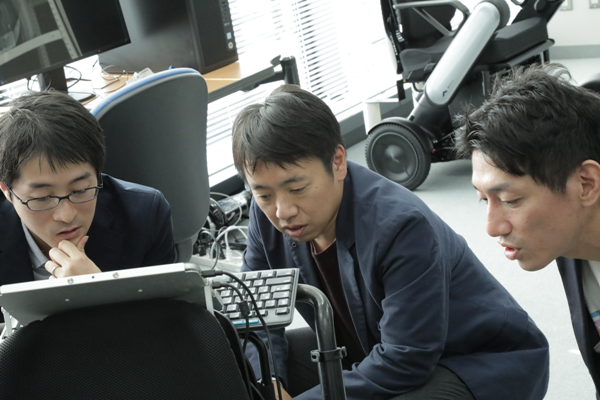
Uematsu: We are focusing on how to get something that can truly be used as fast as possible to the people in the world that need it. I really enjoy the process of actually having them use it and then give us feedback. People with various ideas and various passions combine them with technology to create robots. They don’t just want to make them, they want them to be in a form in which they can be used as intended and have people approve of what they have done so that they can be used in society as soon as possible.
Shirai: I think it is meaningless if what we make doesn’t go out into the world. I think it is very important to have the goal to make them practical and release them to the world. In that sense as well, the project with Panasonic is a good match for me and for WHILL, Inc. in that we are running ahead aiming to make the creations practical.
Q: What is interesting about developing personal mobility?
Shirai: I think it’s important for what I create to have an impact on society. It’s fun for WHILL to be able to challenge a new area. Also, creating things allows me to directly hear from the customer and gives me many opportunities to directly see how I’m having a positive impact on the lives of customers. Hearing such things as, “I’ve had more opportunities to go out since buying WHILL” and “I’ve met many different people by being able to travel around” makes it interesting to create personal mobility.
Imaoka: I like to make things that move and I have worked for an automobile company. There I was only in charge of part of the design, but what I really wanted to do was comprehensively build something that moves from zero. Since I not only make vehicles, I like them, I think that of the people in Panasonic I’m the one riding the WHILL the most. It is very easy to steer and the joystick is easy to operate. Being able to install the automatic stop I created into the WHILL and actually test it was motivating for me.
Uematsu: Since joining the company, I have wanted to make it easier for various people throughout the world to live and I have worked with robots for over 10 years, but it still hasn’t become a business, so I have experienced the related difficulties. I thought it would be great if life would be more convenient for healthy people as well as for people with disabilities, and the current project perfectly matches with that desire. Airports are being targeted this time for WHILL NEXT, but I hope this will be the trigger to spread its use throughout society. Creating a friendly environment for a variety of people is attractive and I think that’s what we should do. Even if what each person thinks is a little different, in the broad sense we are all heading in the same direction and that is what is most fun and significant about this project.
Starting from Robotics HUB
Q: How is a community like Robotics HUB positioned within Panasonic?
Uematsu: In regards to product development, I think its fine to suddenly realize, “So this is where it starts from” and to take a core technology you have in-house and are deciding what to do with and for the meantime taking it to a HUB. Things will start from the Robotics HUB. I think Panasonic will change and I think it will also have an impact on the world. More than anything, I think I’m having the most fun.
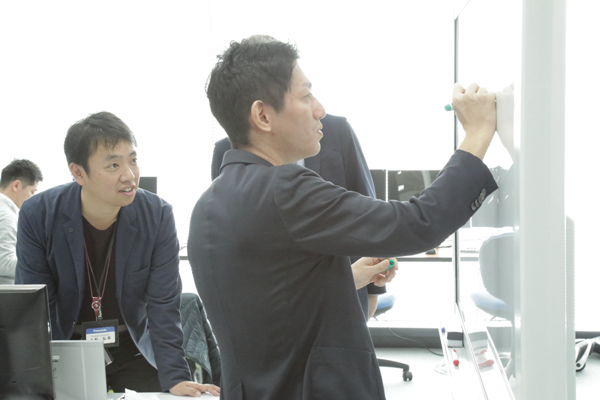
Imaoka: First of all, what is important is to have it be known. I think the first step is having a place to mutually present thinking and ideas. Panasonic is such a big company that I don’t know where to go to consult with someone. In such situations, it’s nice to have a place like this that makes it easy to know where to go. You can work together with the people who will make it and you can bring in the people who you want to be your customers. It is hard for one engineer to do it from zero. For that reason I think it would be great to have an environment that makes it easy for people to come together and where you can come to get things done.
Shirai: I think this is a great place to easily share ideas together with Panasonic. I’m grateful to be able to proceed in an environment where people think, “First, let’s give it a try. Even just a prototype is OK.”
Imaoka: Rather than holding a gloomy meeting, it’s nice to have a place to hold demonstrations and operate things yourself, because actually seeing something is the easiest way to understand and makes it easy to generate ideas. When you see how interesting something is or feel the enthusiasm of the other party, it makes you want to first give a try to something that looks interesting and not thinking to seriously about something makes it easier to do things.
Shirai: Rather than making preparations and creating somethings from zero together, the first step is to try collaborating with what you already have. I think having a place to do that will make it possible for various things together with outside parties and Panasonic.
This article was prepared based on the 【WHILL×Panasonic】 Robotics Engineer Cross Talk video. Go here to watch the video.
